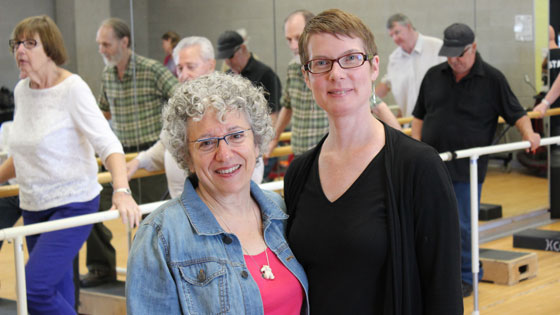
Jo-Anne Howe (left) and Nancy Salbach (right) at a TIME fitness class at Toronto's Harbourfront Community Centre. (Photo: UHN).
George Hojbota is a fitness instructor at Toronto's Harbourfront Community Centre. Four times a week, he teaches a unique fitness class. It's designed for those who live with the effects of aging or neurological conditions such as stroke, acquired brain injury and multiple sclerosis.
His classes may not look like a regular fitness class, but for the people in them, it's the challenging work out they need to stay independent and healthy.
"I feel like I'm making a difference for these participants," said Hojbota. "It's not just exercise, it's a chance to socialize within the community. We have a lot of fun together."
Lack of safe exercise classes in communities
For those diagnosed with stroke, brain injury or multiple sclerosis, rehab programs help them reclaim their independence by regaining motors skills and the ability to walk.
Once rehab ends and patients return home to the community, there is often a lack of safe and doable exercise programs in the area. The result: these individuals can become inactive and lose the gains they made in rehabilitation – their level of disability increases and their health and independence decline.
That's why Toronto Rehab physiotherapists created Together in Movement and Exercise (TIME), led by Clinical Educator and physical therapist, Jo-Anne Howe, in partnership with community centres.
"Our biggest fear is our patients won't get the exercise they need to maintain mobility after they graduate from our rehab programs," said
Howe. "We wanted to create a program in the community to help patients continue exercising."
Community-based exercise
TIME provides people with disabilities with a physiotherapist-designed exercise program, led by fitness instructors in communities across Canada, to get them into motion and to stay healthy and independent. TIME began in Toronto and has expanded as far as British Columbia.
The fitness instructors are trained by Toronto Rehab physical therapists (or designated physical therapists in the respective community) to lead community fitness programs for graduated rehab patients provided for a nominal fee.
"TIME picks up where the formal health-care system leaves off, providing evidence-based and safe exercise for people with balance and mobility limitations from neurological and other conditions," explained
Howe.
TIME is safe, feasible
In January 2013, the Journal of Physical Activity and Health accepted to publish the report from a study of the TIME program led by Toronto Rehab adjunct scientist Dr. Nancy Salbach, who found improvements in balance and walking in stroke survivors who completed the program.
"We evaluated the safety, feasibility and impact of the TIME program," said Salbach. "We found the program was beneficial to patients on many levels. Ultimately, it offers equitable access to recreation for the less-able bodied."
The TIME program began in two Toronto locations. Now, it's in 15 Canadian communities.
To register for a TIME program, patients will need a referral from their doctor. Patients are also required to walk (with or without aid) for a minimum of 10 metres.
The TIME program has also expanded to welcome any patients with balance and mobility issues.
Related
TIME Program on CTV
TIME Program on Simcoe.com
